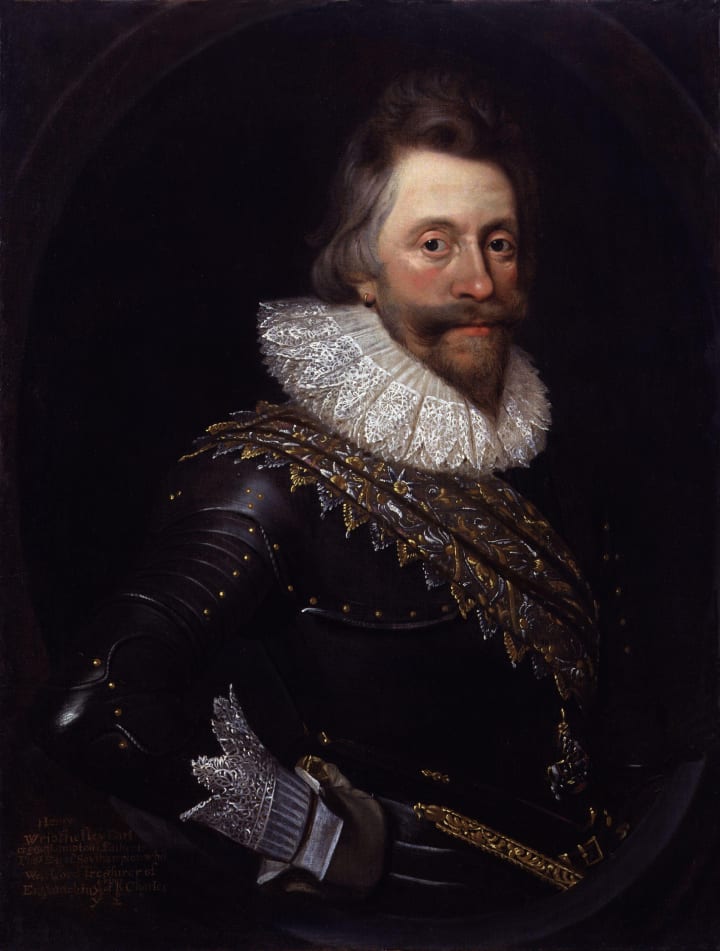
William Shakespeare didn’t only write plays. He also wrote a number of poems, including one collection that now ranks among his most celebrated works. His first however was Venus and Adonis, a long poem about an episode from Classical mythology which Shakespeare will have read in Ovid’s Metamorphoses when he was still at school. It was published in 1593.
Venus and Adonis was dedicated to a man called Henry Wriothesely, the Third Earl of Southampton, Baron of Titchfield, and Shakespeare’s patron. In those days, a patron would be a nobleman who gave support to a young writer still at the beginning of his career, in exchange for a dedication in that writer’s work. Sometimes the support in question would be financial, and sometimes nothing more than a beneficial lending of the nobleman’s good name (this was genuinely helpful in a way it wouldn’t be today, since English society was still rigidly class-based). The system of aristocratic patronage existed long before Elizabethan times, and continued for more than a century after.
Henry Wriothesely should properly be referred to as Southampton, since tradition dictates an Earl is addressed by the name of his lands. He loved the theatre, and it was presumably there he and Shakespeare met. In his dedication to Southampton, Shakespeare describes Venus and Adonis as “the first heir of my invention,” which is to say, his first serious work. We know however that at least a few of Shakespeare’s plays had already been written by 1593, and of course it was both courtesy and sound economy for an author to flatter his patron. It’s hard to say, therefore, whether Shakespeare really viewed Venus and Adonis as such a high achievement. Certainly the history of literature has not remembered it as anything especially momentous.
In the same dedication Shakespeare also promised to write for Southampton a new poem, one that would deal with a more serious subject than Venus and Adonis. Sure enough, that work emerged the following year. The Rape of Lucrece was Shakespeare’s second long poem, published 1594, and it dwelled on a heavy theme drawn from Ancient Rome.
The Rape of Lucrece’s dedication to Southampton was somewhat heavier than the previous one too. Here Shakespeare declares to his patron: “The love I dedicate to your Lordship is without end,” and tells him: “What I have done is yours, what I have to do is yours, being part in all I have, devoted yours.” This goes a little beyond common flattery and courtesy!
Over the years many scholars have puzzled over these words, and the whole of Shakespeare’s mysterious relationship with Southampton. It has been suggested that they were more than author and patron, more than friends, and may in fact have been lovers.

Later in life, after becoming a soldier, Southampton appears to have been a handsome and grave sort of middle-aged man. Shakespeare however knew him when he was only twenty-one, a carefree youth, a little lazy and a little wild. Southampton was apparently reluctant to get married, and as we’ve seen, spent most of his time watching plays with friends.
The young Southampton was also famous for his good looks, and seems to have caught the eye of many of his contemporaries. Shakespeare, some believe, was among them. Nicholas Hilliard’s famous miniature portrait of 1594 reveals that in an era when it was the custom for men to wear short hair and beards, Southampton opted instead for long flowing red hair, and a clean-shaven face with a rather smouldering expression. There are accounts from the time describing him as “gentle and debonair,” a “star,” and a “narcissus” (of which usage we must make what we will, in the light of its present-day meaning).
Whether Shakespeare fell in love with Southampton, as so many evidently did, remains one of the most popular debates of English literature. We’ll see in a moment however that Shakespeare gave a part in some of his greatest poetry to a beautiful and effeminate young man...

Shakespeare went on to write other poems as his career proceeded. In 1599 two sonnets written by him appeared in an anthology titled The Passionate Pilgrim, along with some poetic passages adapted from his play Love’s Labour’s Lost, and work by other authors. In 1601, Shakespeare’s short poem ‘The Phoenix and the Turtle’ was published as a part of Robert Chester’s book Love’s Martyr. Shakespeare also wrote a poem called ‘A Lover’s Complaint’, which would first see print in 1609 as part of his greatest poetry collection, the Sonnets.
A sonnet is a type of fourteen-line Italian poem which was introduced to England by Sir Thomas Wyatt, whereupon a native English variety evolved. This style is now sometimes referred to as the Shakespearean sonnet, because Shakespeare wrote 154, and they are now regarded as some of the most significant love-poems ever produced in any language.
The Sonnets were first published together in 1609, apparently without Shakespeare’s permission. This, and the fact that they are the only works by Shakespeare where he writes in the first-person (which is to say, uses “I” and “me”) has excited many scholars throughout the ages. Such readers believe that here, and nowhere else, Shakespeare reveals his deepest and most secret autobiographical truths.
Besides the poet-narrator of the Sonnets, who may or may not be supposed to be Shakespeare, there are three other characters in the sequence. Traditionally they are known as the Fair Youth, the Rival Poet and the Dark Lady. Whether they are based on real people Shakespeare knew has been speculated over for centuries, and endless attempts have been made to determine who each of them were. One highly popular belief, however, is that the Fair Youth is based on Southampton. Like the man himself he is physically beautiful, leads a decadent life, and has no wish to settle down. The poet devotes much time to urging him to marry and have a son, reminding him he won’t be young and beautiful forever. Moreover, in Sonnet 20 the poet famously confesses his love for the Fair Youth, while acknowledging too they can never be together.
As with so much else of Shakespeare’s life, all we can conclude is...who knows?






Comments (5)
The skillfull weaving of historical context and literary analysis, making it an engaging read for both Shakespeare enthusiasts and those new to his works. Fantastic work.
Fabulously interesting and intriguing!!! Loving it!!!♥️♥️💕 It's not Shakespearen, but check out my latest Limerick, TEEN SPIRIT.
Shakespeare and Southampton sitting on a tree. K-I-S-S-I-N-G 🤣🤣🤣 Lol, just ignore me. This was a fascinating read!
A fascinating and intriguing look at the life (and loves?) of Shakespeare! Great job, Doc!
Great work